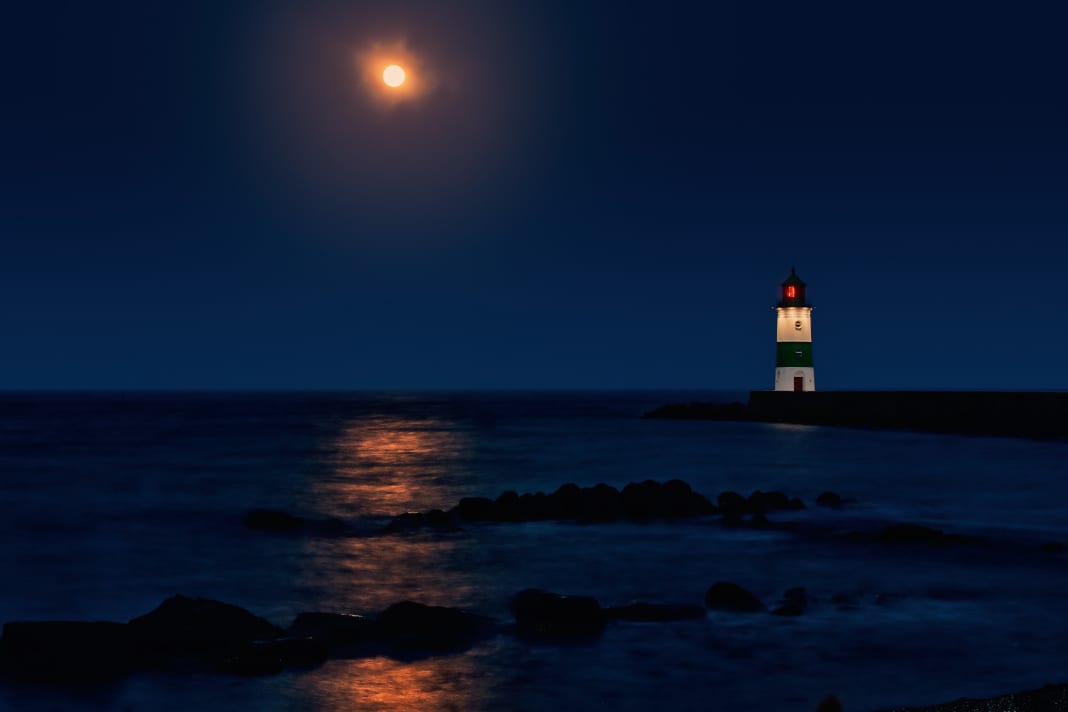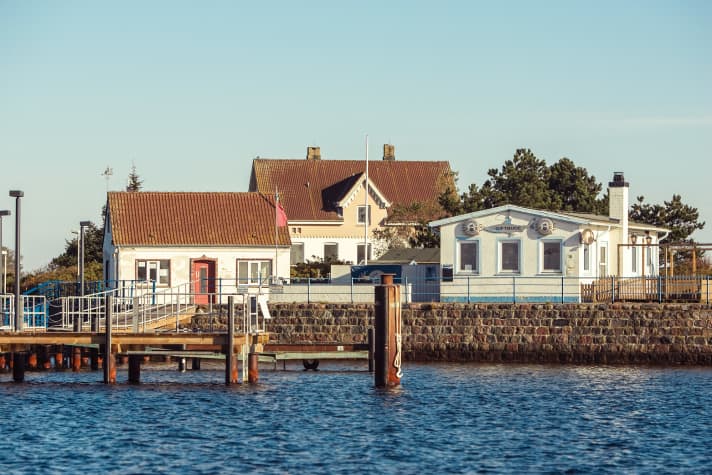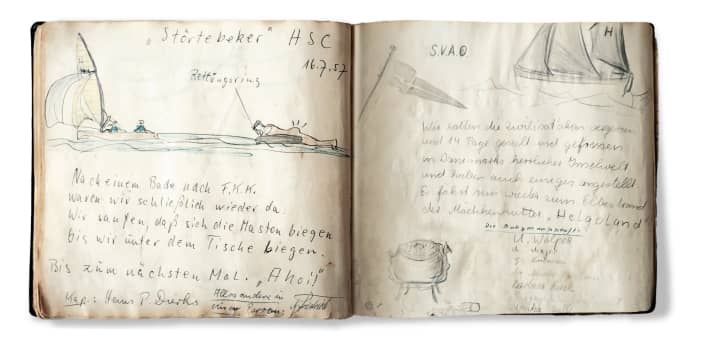





There are places that no one can make up. They don't need many words and yet everyone talks about them. And then everyone wants to go there. Once in a lifetime, but preferably every summer. Just to be here and do what it's all about in the end - enjoying life. There is a magic in the air, the magic is natural.
Schleimünde is one such place. To the north is the striking group of trees. To the east, on the pier, is the green and white-painted lighthouse. But apart from that, there's not much else up there. Just vast, wet land. The Baltic Sea in front of it. Green water washes around the sandbanks and reefs, reeds glisten on the shores. Wading birds perch on the salt marshes, oystercatchers circle above the mussel beds.
Sun, yes, there is sun. But the next gust of wind is already sweeping over the wind tidal flats, clouds drifting over this strip of light-coloured sand. Watery earth, sea of land - this place can't decide what it wants to be. But it doesn't need to be. It is both. Some say it is the most beautiful spot on earth between Flensburg and Rügen. There are hardly any Baltic Sea sailors who have not yet entered the coordinates into their GPS. Why might that be? Well, perhaps also because strange things happen up here.
The best thing about Schleimünde: It can only be reached by boat
Grown men suddenly start drawing sailing boats. They start rhyming, possibly even singing. They will almost certainly have a second beer. Afterwards, the typical Schleimünde visitor strolls back across the jetty to his boat and simply sits in his cockpit. After all, that's the best thing about this place: it can only be reached by boat.
However, the presence of water is just one of the things that makes this place so magical. Up here, surrounded by windswept meadows, there is another phenomenon that has made Schleimünde famous. A shack. Nothing but a little house with a few chairs and tables. Inside there is room for 30 guests. Outside, on the terraces, another 30 can sit. Depending on the wind direction and the position of the sun.
The Butze stands calmly in the middle of the flat world and welcomes water travellers with an unagitated gesture. There are no table reservations. You can't even pre-book a berth in the small harbour next door. For the sake of fairness, say the operators. Whoever comes, comes.

The "Giftbude", a place of longing on the Baltic Sea
Once the crews have moored, the big moment follows. They enter a pub at sea that probably only exists once. A mixture of pub and fish stall, surrounded by avocets and redshanks. A combination of harbour pub, French fries paradise and matjes heaven that is unlikely to be found anywhere else on this planet.
A must in the logbook. An epicentre in the network of Baltic Sea longing destinations. The name of this place is correspondingly mystical: "Giftbude". Everyone knows the hut. Has heard of it. The small restaurant has always been the centre of attention out here on the lonely pilot island. Everyone wants to go here. This is where everyone wants to be - in the Sanctum Sanctorum of Schleimünde.
Schleimünde was originally a port of refuge
But everything was completely different at the beginning. Nobody wanted to come here! Schleimünde served as a port of refuge for a long time. Anyone who ended up here was stranded or otherwise stuck. In the 1920s, the aforementioned hut was built for this reason: to offer sailors and workers shelter in bad weather, a dry bed and a warm meal. Hence the name. There was a "poison" here, as it is called in Old High German. A "gift" for sailors who had been blown in.
And no: raise your glasses, good luck ahead - that was by no means the motto back then. The "Giftbude" was the place to go if the wind and weather were blowing around your ears. Schleimünde was a place of refuge. For some, it may even have been their last resort.
The reinterpretation took place after the war. The first pleasure craft headed for the picturesquely branded estuary. Spitzgatter, yawls and pretty cruisers suddenly appeared in front of the lighthouse. Because word had long since got around: "Dream spot up there! And then this place!" The boats came from Kiel, Hamburg and Berlin. And soon there were more and more. Flotillas of rowing boats, kayak teams and canoe boys headed for Schleimünde. No longer as a harbour of refuge - but to have fun there.
The stop at the "poison shack" is part of it
They came from the north and the south. No boat that left the Schlei to explore the vastness of the Baltic Sea failed to make a stop here. No boat returning from the vastness of the Baltic Sea missed mooring here again. Departure beer. Homecoming beer. Never mind, everything has always flowed here. The Baltic Sea, the Schlei, the clouds, the rain.
Schleimünde thus became a kind of Kehrwieder paradise - and the little shack epitomised all sailing fantasies of the Baltic Sea. A North German saloon on the edge of the Schleswig-Holstein prairie, located somewhere up there between Denmark and Kiel, between legendary outposts with names like Pommerby, Maasholm and Schubystrand.
The guest books of the "Giftbude" as contemporary witnesses
Today, everyone knows the "Giftbude". It is a Baltic Sea rarity: cult. But what really happened up here on many a boozy evening is something that only the meadows and the landlord know. All the more dramatic is an incident that happened a few years ago. A change of tenant was imminent. First the old, then the new operators of the "Giftbude" mucked out, cleared out, rebuilt. And in the process, they were also in danger of disappearing: the old guest books that had been on display here since the post-war years.
Jan-Willem Paulsen from Arnis had the presence of mind to intervene just before the treasures could end up in the rubbish and saved the high-percentage cultural assets from destruction. "These books must not be thrown away! They are contemporary witnesses! They are treasures!"
And luckily they are still there. Four old, tattered books, the pages yellow and stained. On them: sailing ships - drawn. Clouds, wind and sun - nicely sketched with a pen, felt-tip pen, pencil or whatever else was to hand when the tenth beer arrived. And because it's no joke that seasoned skippers start rhyming when they touch down in Schleimünde, this is also true: the guest books of the famous "Giftbude" are full of lines, sayings and poetry. The Baltic Sea, the summers, the ships and the wind. The concentrated happiness of life - captured on paper.
Storm, fun and spirits
A glance at the guest books reveals how Schleimünde became a saga - from an emergency harbour to a place of desire and thirst for life. The first entries date back to May 1957. Simple lines like these: "The wind was blowing hard, but we had courage. We travelled to Schleimünde, that was good." Signed: the crew of the "Seelöwen" under Captain Helmut Homfeld from Kiel.
A little more beer and possibly something stronger must have flowed before a crew member scribbled these prosaic lines in the guest book: "The sea is green, the loo is blocked - someone is always standing in front of it." On the next page is this motif: a sketched seadog with a bobble hat and a pipe in his mouth. Signed by Rudolf Halmschlag, May 1957: "Pustedöfchen - ich wer uk hier". The comment from the three-man crew of the "Drachenfliege" is similarly simple, but probably meant rather ironically: "The whole life would be easier to bear if it weren't for this damn sailing!!!"
And so the summers up there in Schleimünde took their course. Boats came and boats went. And the reputation of this little corner of the world swelled with every wake that was lost in the green waters in front of the "Giftbude". Countless stories were left behind. Fantastic anecdotes and legendary evenings that probably took place up there on the gurgling shore.
It is now June 57 and the nights are already hotter, as the crew of a dinghy describe their stay in the Schleimünde in the guest book: "The trip was pretty tough, but our beard grew mightily. Even though we were wet and frozen through, beer and rum did not remain unscathed. My captain asked for a beautiful girl, which also made my heart beat faster."

"The girls on the Schlei are not prudish at all"
At the bottom of the page, the lines are already slightly wringing, you can read this summary: "The girls on the Schlei are not at all prudish, so we got little sleep and were always tired." It is no longer possible to reconstruct how many days and nights the crew of this summer-roaming sports boat stayed. In the end, finely drawn on paper, the sloop sails away. In the speech bubble the command: "Tighten the sheet!"
The entries in the guest books read like emblems of collective sailing pleasure. Pages of summer happiness under white cloths. It goes back to the 1960s. Colourful ships and fantastic boats cruise across the paper amidst stylised cloud images and wild water worlds.
Personal ad via guestbook
All painted and finely drawn, signed by a thousand crew names, decorated with all kinds of life wisdom. For example, the crew of the sailing yacht "Seeteufel" - presumably squatting blissfully in front of the "Giftbude" - writes down these lines: "Oh horror, oh horror, soon we'll be back home. Everything was wonderful on holiday. If only we could turn back time, we'd move back to the Baltic Sea." Signed: Captain Heinz and Smutje Friederike Lühmann, Schleimünde, 6 August 1963.
In the summer of 1969, one lady even got up the nerve to write a personal ad in one of the guest books. She had spent her holiday in Schleimünde, she noted legibly, "including many pleasant hours in the 'Giftbude'". Without a boat of her own, she continues: "Can't sail, but I can cook and get back on board. I'm very tall (1.72 m), slim, blue-eyed, short dark blonde hair and 20 years young. I can speak English, too! Please, I like to get your letter."
Oh, Schlei. How beautifully you can seduce and flow into pure sailing pleasure. "See you soon," writes the next skipper openly. And adds: "We'll be back next year and drink our hearts out with the nice landlords."
In the 80s and 90s, the entries become more sober
The entries in the guest books of the "Giftbude" continue into the 1980s. You can read endless cheerful notes, comments from ship crews from all directions, although the poetic and pictorial elements are now clearly dwindling. The rhymes diminish, and hardly any handmade drawings fill the pages. At the end of the 1990s, the guest book tradition à la "Giftbude" seems to have finally faltered. Presumably the first sailors with mobile phones are now appearing. And then what has to happen, happens. The word is dead, the selfie wins. Yes, even up there on the Schlei.
This does not detract from the happy existence at the mouth of the Schleim. Sailors come and go to this day. "Giftbude" remains "Giftbude": without question one of the most stunning places on the Baltic Sea.
However, this place is by no means a matter of course - the estuary of the Schlei is a dynamic landscape, shaped by wind and waves and reshaped every year by storms and currents. Sometimes the waves gnaw alarmingly at the beach walls, the water rises over the edges of the shore. Then again, the drying sands glow and the sun paints everything blue and silvery. Here, too, everything is in a state of flux. Nothing stays the same. That's why man has had to help again and again to ensure that this place exists at all.
Schleimünde is constantly changing
The navigable connection between the Baltic Sea and the Schlei, which we know today and on the northern shore of which the "Giftbude" stands, was created artificially over 200 years ago. Workers fortified piers, washed away sediment and erected protective walls. The only natural passage had long been much further north, but at some point the passage became too shallow until it finally silted up. Pilot Island lies between these two streams of water. Sometimes a real island, then again part of the land, connected by sands and mudflats, covered in grass and silt.
Definitely a sublime spot for the coolest pint between Kiel and Kappeln. Mooring your own boat out here and cooling your salty throat with a good drink - this was once, and still is, one of the most heavenly sailing experiences to be had. A guestbook entry from August 1995 puts it in a nutshell. The crew of the cruiser "Elguste" wrote: "Here - here in Schleimünde, 'Giftbude' - here with 'Elguste' in the water, here in the wind and the sky above us, I was closest to God."
More is not possible.
Only one, that's still possible!
Aid campaign for Schleimünde
The small idyll at the mouth of the Baltic Sea fjord was severely damaged by the storm surge in October and is closed to pleasure craft for the time being. Around 130,000 euros and many hours of voluntary help are needed to rebuild it. The Schleimünde near-natural water hiking site support association is calling for help with its "Save Schleimünde together" campaign to help in any way you can, whether with your own labour, construction equipment, materials or financially. The link below leads to a form that can be used to offer the type and scope of help. The initiators coordinate the offers of help.

